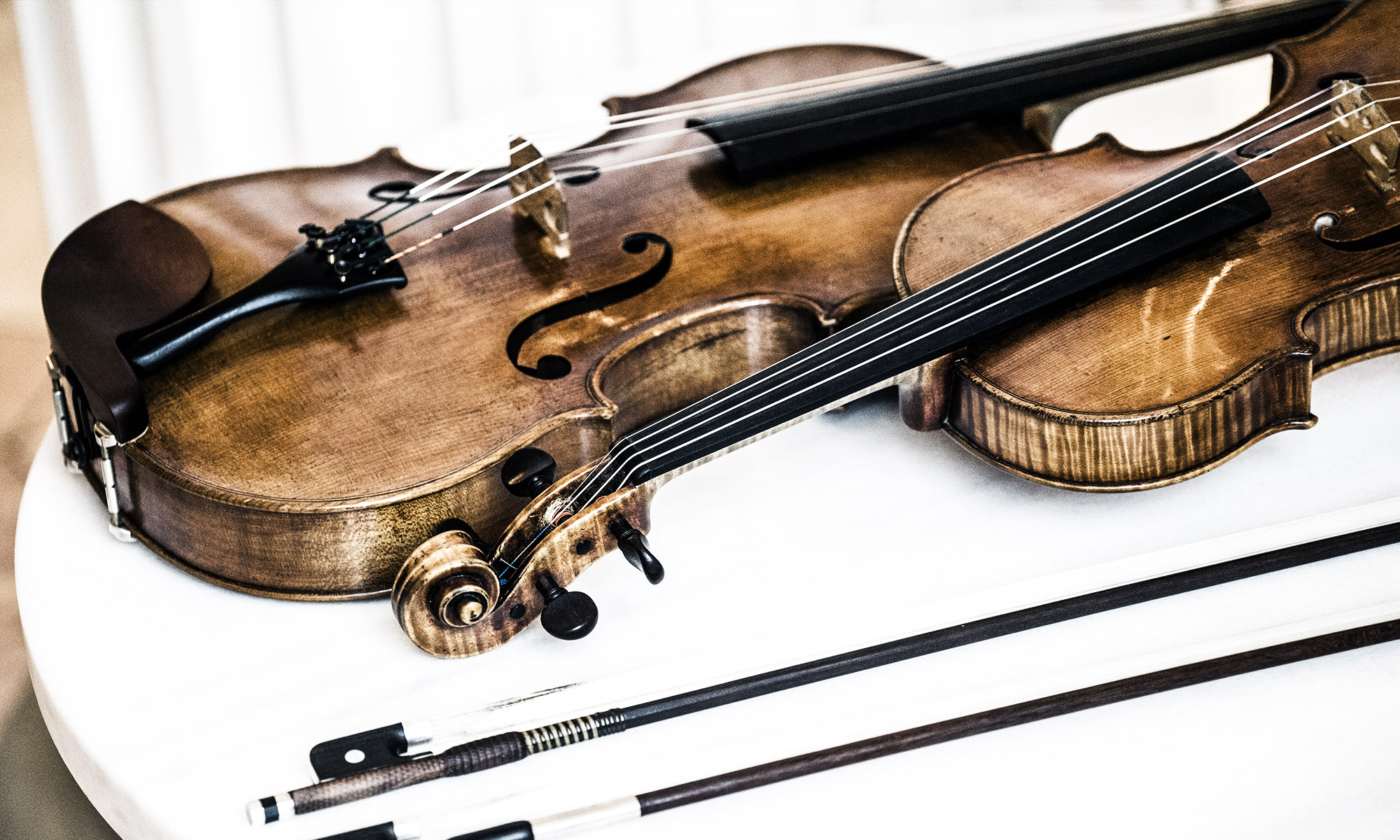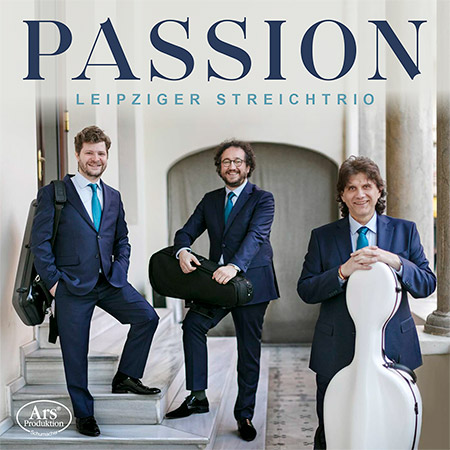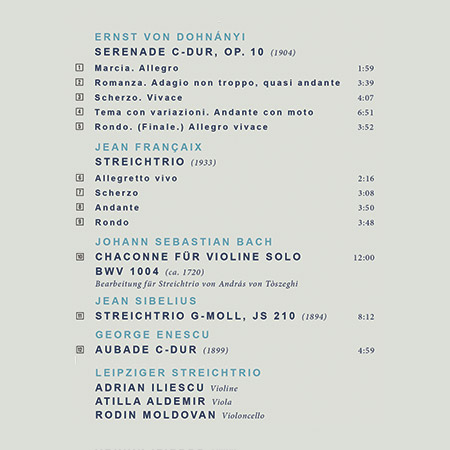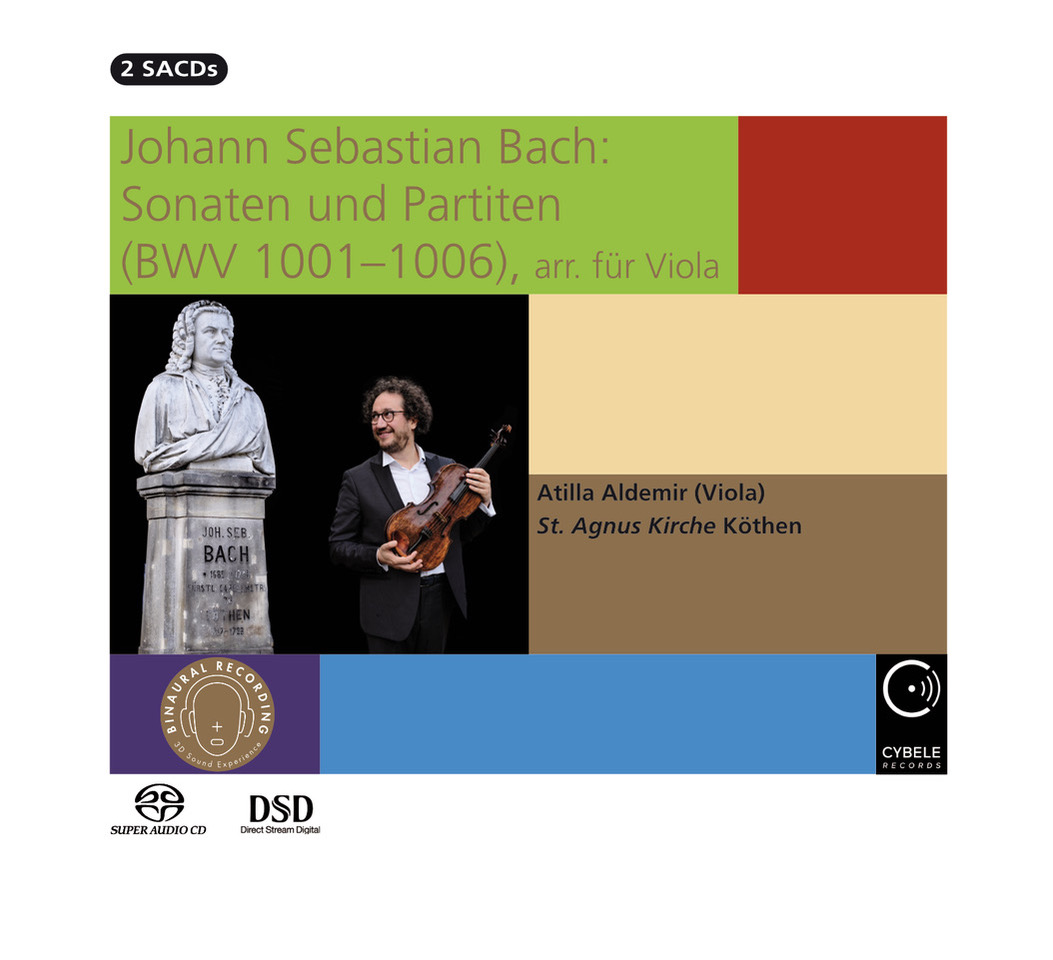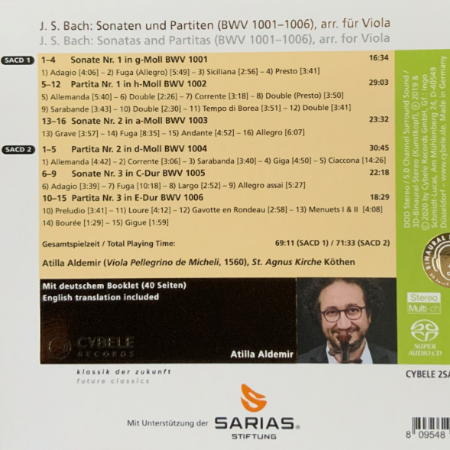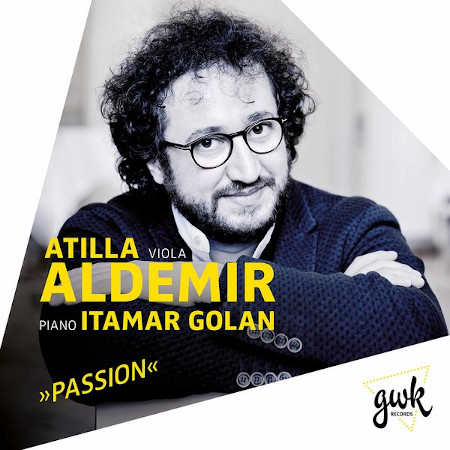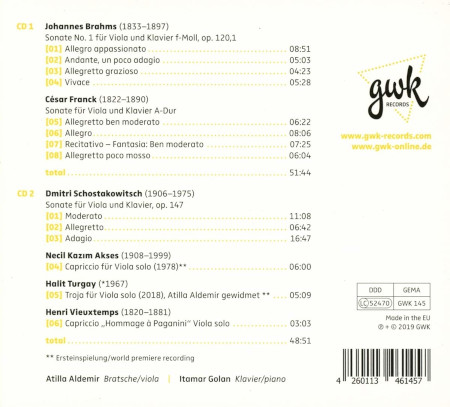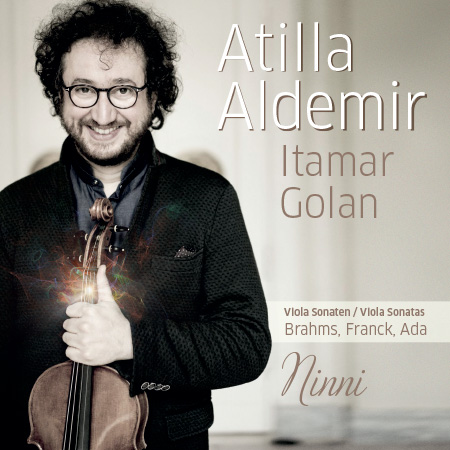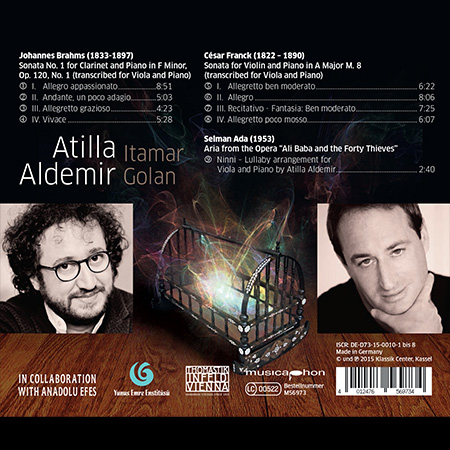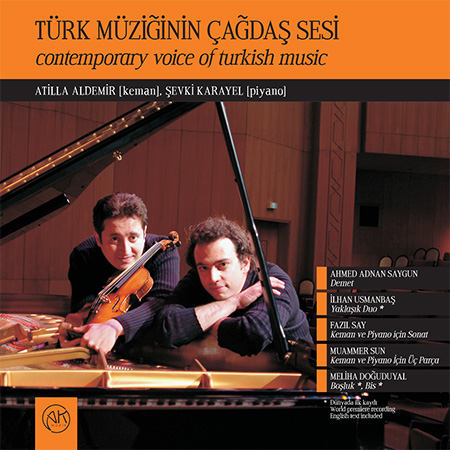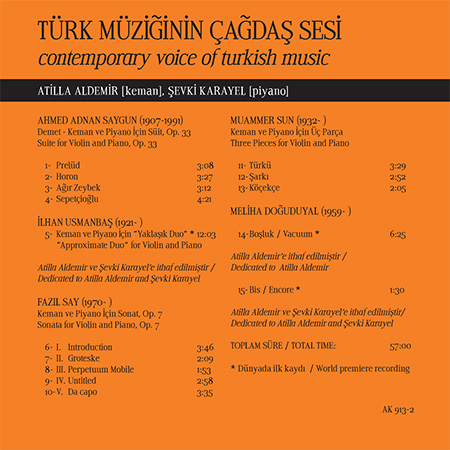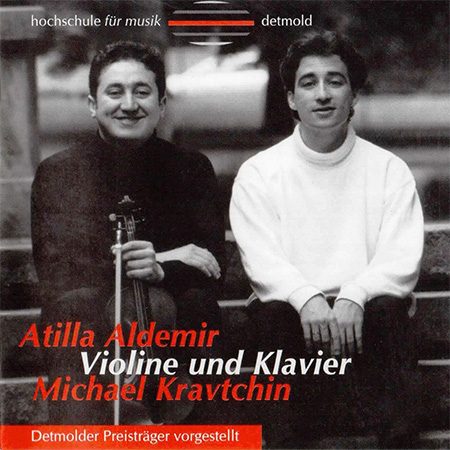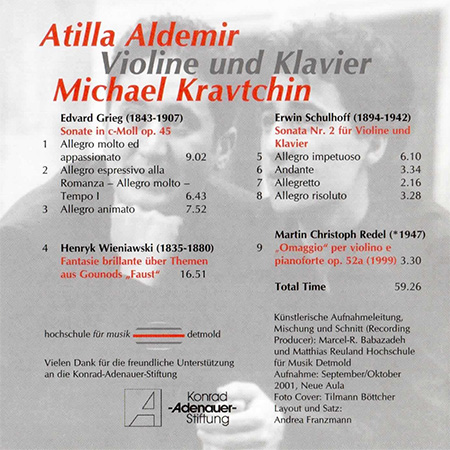REZENSIONEN/REVIEWS (deutsch&english)
CD “PASSION“
ALDEMIR&GOLAN
29.07.2020
Kurz gefasst:
1- FONO-FORUM (Carlos María Solare), Juli 2020
Atilla Aldemir ...legt mit dieser Doppel-CD eine ansprechende „Visitenkarte“ vor, die das breite Spektrum seines Könnens auf eindrucksvolle Weise unter Beweis stellt. Das Ganze gleicht einem großzügig gestalteten Sonaten-Abend, und Aldemir hat dabei in Itamar Golan einen ausgesprochenen proaktiven Partner an der Seite. Der Kopfsatz der Brahms-Sonate wird stürmisch-empathisch gestaltet…. Der dunkle Klang der Bratsche, eines 1560 gebauten Instruments von Peregrino di Zanetto, besitzt allerdings Suchtpotenzial, und Aldemir weiß ihn sensibel einzusetzen, mit schönen „parlando“-Momenten im langsamen Satz. Das Duo geht den ländlerartigen dritten Satz und das Finale schwungvoll-burschikos an.
[Nichts] trübt das Hören der Sonate von Schostakowitsch, dessen Scherzo mit charakteristischer Verbissenheit gelingt, während beim abschließenden Adagio die Zeit gleichsam angehalten wird.
Zum Schluss wechselt Aldemir zu einem neuen Instrument von Alexandre Breton, Baujahr 2017, dessen direkterer Klang sich als perfekt für die zeitgenössischen türkischen Werke erweist. Aldemir arbeitet die volkstümlichen Elemente von Akses' Capriccio sehr dezent heraus und bringt die Oud-Imitation in Turgays Troja überzeugend hervor. Das Capriccio von Vieuxtemps ist eine perfekte Zugabe.
With this double CD, Atilla Aldemir ... presents an appealing “calling card”, which impressively demon-strates the broad spectrum of his skills. The whole record resembles a generously designed sonata evening, and Aldemir has a decidedly proactive partner in Itamar Golan at his side. The first movement of the Brahms Sonata is designed in a stormy, empathetic manner ... The dark sound of the viola, an instrument built in 1560 by Peregrino di Zanetto, has potential for addiction, however, and Aldemir knows how to use it sensitively, with beautiful “parlando” moments in the slow movement. The duo ap-proaches the ländler-like third movement and the finale sweepingly boisterous.
[Nothing] clouds the hearing of Shostakovich's Sonata, whose Scherzo succeeds with characteristic doggedness, while in the concluding Adagio time is virtually halted.
At the end, Aldemir changes to a new instrument by Alexandre Breton, built in 2017, whose more direct sound proves to be perfect for the contemporary Turkish works. Aldemir very discreetly elaborates the folkloristic elements of Akses' Capriccio and brings out the oud imitation in Turgay's Troy convincingly. The Capriccio by Vieuxtemps is a perfect encore.
2- FANFARE Magazine/USA, (Philip Borg-Wheeler) May/June 2020
.. The Brahms F-Minor Sonata receives a virile, richly satisfying performance. […] from every aspect—tempos, characterization, commitment, unanimity—the two players bring off this sonata tremendously well.
The performance of Franck's sonata is equally fine—as eloquent in the reflective music as in the passionate and dramatic. Technically also the players deserve accolades..The beautifully played finale, beginning with a melody of radiant innocence treated in canon—a modest beauty making a quiet entrance—concludes a deeply rewarding performance….
Shostakovich's bleakest works. The very beginning, pizzicato open strings, is an only slightly disguised reference to the opening of Berg's Violin Concerto, which is unarguably a death-related piece. The performance here is outstanding. Aldemir and Golan genuinely inhabit this grim world, though they also achieve more light and shade than I have heard in most performances. This is definitely a plus, for no composer of any stature would write even the darkest of works lasting over half an hour without passages of contrasting relief. Apparently Shostakovich includes numerous quotations from his own works in the Adagio finale (as well as repeatedly referring to Beethoven's so-called “Moonlight” Sonata), but I cannot pretend to have identified them all. Atilla and Golan are remarkably successful in conveying the gravity of this music, yet again I have heard many more performances which maximize its grimness to the exclusion of any other feeling. I am grateful to have heard this expressively nuanced interpretation and do not feel the sonata is in any way diminished by this more balanced—perhaps even more human?—approach.
The three shorter pieces are very engaging in different ways. The piece by the Turkish Akses (1908–1999)—a new name to me—is splendidly written for the viola and an impressive work in an accessible idiom. The Turgay is “a lament permeated by frenzied virtuoso outbursts,” as the violist/booklet-annotator remarks—also “deeply rooted in Asia Minor.” Again this is a compelling piece and it is difficult to imagine more eloquent advocacy. The Vieuxtemps Capriccio will be familiar to most violists, a fine piece and deservedly popular.
Atilla's intonation is impeccable while his tonal quality is very beautiful—sonorous, but without that booming which can be oppressive in some violas. He is a complete master of the instrument […] the sound quality and balance are excellent. Atilla's notes are partly personal/autobiographical but also informative and well-written.
…Atilla's intonation is impeccable while his tonal quality is very beautiful—sonorous, but without that booming which can be oppressive in some violas. He is a complete master of the instrument..
"By the way, this CD is highly worth listening to; this is especially the case with the Sonata for Viola and Piano by Dmitri Shostakovich, which is brilliantly performed by the two soloists. With this CD, Aldemir records for the first time solo sonatas for viola by the two Turkish composers Necil Kazim Akses and Halit Turgay: exciting music!"
…Die f-Moll-Sonate von Brahms erhält eine kraftvolle, höchst befriedigende Darbietung.. dass diese Sonate den beiden Interpreten in jeder Hinsicht – Tempo, Charakterisierung, Engagement, Einmütigkeit – außerordentlich gut gelingt. .. Die Ausführung von Francks Sonate ist ebenso gelungen – eloquent sowohl in der nachdenklichen als auch in der leidenschaftlichen und dramatischen Musik. Auch technisch verdienen die Spieler Anerkennung, Das wunderschön gespielte Finale, […] das mit einer Melodie von strahlender Unschuld im Kanon beginnt, schließt eine überaus lohnende Darbietung ab. Schostakowitschs Bratschensonate war sein letztes Werk, und es gibt Anhaltspunkte dafür, dass er sich dessen bewusst war. Dieses Wissen (oder diese Theorie) sollte unser Urteil natürlich nicht beeinflussen, aber wenn es wahr wäre, hätte dieser Umstand sicherlich den Ton des Werkes beeinflusst. Es gehört zweifellos zu den trostlosesten Werken Schostakowitschs. Schon der Anfang ist ein nur leicht versteckter Hinweis auf die Eröffnung von Bergs Violinkonzert, das unbestreitbar mit dem Tod zusammenhängt. Die Ausführung hier ist herausragend. Aldemir und Golan leben wahrhaftig in dieser düsteren Welt, obgleich sie auch mehr Licht und Schatten erzielen, als ich bei den meisten Aufführungen gehört habe. Das ist definitiv ein Gewinn, denn kein Komponist von Format würde selbst das dunkelste Werk, das über eine halbe Stunde dauert, ohne Passagen von kontrastierender Befreiung schreiben. […] Atilla und Golan gelingt es bemerkenswert gut, die Gravität dieser Musik zu vermitteln, und wieder einmal habe ich viele weitere Interpretationen gehört, die ihre Grimmigkeit unter Ausschluss jedes anderen Gefühls maximieren. Ich bin dankbar, diese ausdrucksstarke, nuancierte Interpretation gehört zu haben, und ich habe nicht das Gefühl, dass die Sonate in irgendeiner Weise durch diese ausgewogenere – vielleicht sogar menschlichere – Herangehensweise geschmälert wird.
Die drei kürzeren Stücke sind auf unterschiedliche Weise sehr einnehmend. Das Stück des türkischen Komponisten Akses (1908–1999) – ein neuer Name für mich – ist wunderbar für die Bratsche geschrieben und ein beeindruckendes Werk in einer zugänglichen Tonsprache. Turgay ist „ein von rasenden virtuosen Ausbrüchen durchdrungenes Klagelied“, wie der Bratschist und Booklet-Kommentator bemerkt, und außerdem „tief in Kleinasien verwurzelt“. Auch dies ist ein überzeugendes Stück, und es ist schwer vorstellbar, sich eine eloquentere Fürsprache vorzustellen. Das „Vieuxtemps-Capriccio“ wird den meisten Bratschisten bekannt sein, ein schönes Stück und verdientermaßen beliebt.
Atillas Intonation ist tadellos, während seine klangliche Qualität sehr schön und klangvoll ist, aber ohne das Dröhnen, das bei manchen Bratschen durchaus erdrückend sein kann. Er ist ein vollkommener Meister des Instruments..
3- DAS ORCHESTER (Franzpeter Messmer) Mai 2020
Online lesen
…Erfreulicherweise entfalten die beiden Künstler in den folgenden Sätzen ein weites Spektrum mit höchst differenzierten Viola- und Klavierklängen und unterschiedlichsten Schattierungen.
Die A-Dur-Sonate von César Franck spielt Aldemir in großen, ausdrucksstarken Melodiebögen. Dies wird dann in der Sonate von Schostakowitsch deutlich, die der Viola auf den Leib geschrieben wurde. Allein schon der Anfang mit Pizzicato der Viola und perkussiv hingetupften Klavierklängen ist faszinierend und wird von den beiden Solisten mit größter Delikatesse musiziert. Wenn dann die Viola zu ihrem Melodiespiel ansetzt, entsteht eine Leidenschaftlichkeit, wie sie nur auf diesem Instrument dargestellt werden kann. Im „Allegretto“ gestalten Aldemir und Golan mit hörbarer Freude die skurril-grotesken Rhythmen und Melodien und tauchen den Hörer im „Adagio“ in die Stimmung von Beethovens „Mondschein-Sonate“ ein, deren Motive Schostakowitsch zitiert.
Aldemir gelingt es, mit der Bratsche Melancholie, Trauer und Transzendenz einzufangen und die Intensität der Musik zusammen mit der kongenialen Begleitung von Golan zu höchster Leidenschaft zu steigern. In den folgenden Werken für Viola solo präsentiert sich Aldemir als technisch versierter Virtuose, der uns mit seinem ausdrucksvollen Spiel unbekannte Musik der türkischen Komponisten Necil Kâzım Akses und Halit Turgay schätzen lehrt.
…in the following movements the two artists unfold a wide spectrum with highly differentiated viola and piano sounds and the most diverse shades.
Aldemir plays the A major Sonata by César Franck in large, expressive melody arcs.
the listener realizes that the “passion” of a violin is different from that of the viola. This becomes clear in Shostakovich's sonata, which was written with the viola in mind.
The beginning alone, with pizzicato on the viola and percussively dabbed piano sounds, is fascinating and is performed by the two soloists with the greatest delicacy. When the viola then begins to play its melody, a passionate mood emerges that can only be displayed on this instrument. In the “Allegretto”, Aldemir and Golan shape the bizarre grotesque rhythms and melodies with audible joy, and in the “Adagio” they immerse the listener in the atmosphere of Beethoven's “Moonlight Sonata”, whose motives are quoted by Shostakovich.
Aldemir succeeds in capturing melancholy, sadness and transcendence with the viola, and together with the congenial accompaniment of Golan, he raises the intensity of the music to the highest passion. In the following works for solo viola, Aldemir presents himself as a technically accomplished virtuoso, who with his expressive playing teaches us to appreciate unknown music by the Turkish composers Necil Kâzım Akses and Halit Turgay.#
„By the way, this CD is highly worth listening to; this is especially the case with the Sonata for Viola and Piano by Dmitri Shostakovich, which is brilliantly performed by the two soloists. With this CD, Aldemir records for the first time solo sonatas for viola by the two Turkish composers Necil Kazim Akses and Halit Turgay: exciting music!“
4- RITMO (Bianco Gallego), Januar 2020
Atilla Aldemir vertieft sich in Werke von besonderer Dichte und Qualität […]
..Aldemir, in den drei großen Werken begleitet von dem hervorragenden Pianisten Itamar Golan, bietet uns einen wunderschönen Klang und ein besseres Verständnis dieser Werke, insbesondere in der Sonate Op. 147 von Shostakovich, in deren absoluten Pessimismus sich beide Musiker vertiefen.
..Aldemir, in the three great works accompanied by the outstanding pianist Itamar Golan, offers us a beautiful sound and a better understanding of these works, especially in the Sonata Op. 147 by Shostakovich, in which both musicians delve into its absolute pessimism.
5- O-Ton Kulturmagazin, (Michael O. Zerban) 12.01.2020
Bitte klicken Sie hier, um den Beitrag anzuhören
…gelungene und sehr hörenswerte Einspielung…
6- CD des Tages bei radioklassik.at 10.01.2020
Bitte klicken Sie hier
7- RITMO (Bianco Gallego), Dezember 2019
Online lesen
“Ich wollte drei Spätwerke von drei großen Komponisten spielen, die für Bratsche komponiert haben, welche sind Shostakovich, Brahms und Franck, dessen Violinsonate hier für Bratsche arrangiert ist”, erzählte uns letzten Monat der großartige Bratschist Atilla Aldemir in einem RITMOS Interview.
8- The New Listener (Stefan Pieper), 27.12.2019
Online lesen
„Neue Wege einschlagen, ohne aus einer alten Kirche Disco zu machen“
Atilla Aldemir kam als Spätberufener zur Viola – oder ist es zutreffender, zu sagen: Die Viola hat ihn gefunden? Auf einem Streichinstrument die Mittellage zu entdecken hat bei ihm etwas mit „sich selbst erfinden“ zu tun. Seine neue Doppel-CD vereint Meisterwerke aus Westeuropa mit aktuellen türkischen Kompositionen. Vor allem Spätwerke hatten es ihm bei der Auswahl angetan, da sich gerade hier die emotionale Reife bündelt. Mit der emotionalen Reife geht eine spirituelle Dimension einher. Stefan Pieper traf den umtriebigen Vollprofi in der lauschigen Kantine des Berliner Konzerthauses. Diese Spielstätte und ihr Orchester waren für ihn von 2013 bis 2017 künstlerische Heimat, bevor er seine Stelle als Solobratscher im MDR-Sinfonieorchester antrat.
9- Klassik Heute (Verena Düren), 10.12.2019
Online lesen
„Die Leidenschaft Aldemirs für sein Instrument und die von ihm gewählten Werke wird auf dieser Doppel-CD in jeder Minute deutlich… Hört man seine neue Aufnahme, so ist man versucht, zu sagen, dass diesem Instrument sein Herz gehört“
„Bereits von den ersten Takten der Brahms-Sonate an gelingt es Aldemir, den Hörer mit seinem leidenschaftlichen Spiel, aber auch mit dem warmen Timbre dieses Instruments in seinen Bann zu ziehen. …Gerade wenn man Francks Original-Version mit Violine im Ohr hat, so wird deutlich, wie sehr das Werk durch die Verwendung der Bratsche klanglich und an Intensität gewinnt. Durchgehend schlicht brillant gespielt ist Schostakowitschs Werk, das er noch auf dem Sterbebett vollendete.“
„Sein im wahrsten Sinne des Wortes leidenschaftliches Doppel-Album beschließt Atilla Aldemir mit einer Liebeserklärung an das Werk, das ihn zur Bratsche gebracht hat, das innig und hochvirtuos gespielte Capriccio Hommage à Paganini von Henri Vieuxtemps…. Ein tolles Finale und ein ausgesprochen intensives.”
“The violist Atilla Aldemir has entitled his latest record, released by the gwk label, 'Passion', and in fact, the title could not have been better chosen. ... Listening to his new recording, one is tempted to say that his heart belongs to this instrument”
“From the very first bars of the Brahms sonata, Aldemir manages to captivate the listener with his passionate playing, but also with the warm timbre of this instrument…Shostakovich's work, which he completed on his deathbed, is played brilliantly throughout.”
“Atilla Aldemir concludes his literally passionate double album with a declaration of love for the work that brought him to the viola, the intimately and highly virtuosically played Capriccio Hommage à Paganini by Henri Vieuxtemps.... A great finale and an extremely intense one.”
10- SWR2 (Treffpunkt Klassik, Dorothea Bossert), 8.12.2019
Online lesen
„…die Violinsonate von César Franck in einer Fassung für Viola. Das traut sich kaum jemand. Das klingt sehr überzeugend … die Franck-Sonate tiefergelegt, in leidenschaftliche Altlage. Während die Geiger die Leidenschaft und Spannung dieser Sonate eher aus einem virtuos-furiosen Rubatostil aufbauen, setzt Attila Aldemir auf die Erotik und Durchschlagskraft der satten, sonoren Tiefe seines Instrumentes und interpretiert die hohen Lagen als wären es arpeggiohaft angerissene Obtertonspektren. …“
„Unbedingt hörenswert ist der Klang seines Instrumentes …: sonor und kraftvoll in der Tiefe, mit einer warmen, dabei leichten und fast silbrigen Höhe, wunderbar ausgeglichen in allen Lagen.“
“…the violin sonata by César Franck in a version for viola. Hardly anyone dares to do that. That sounds very convincing … the Franck sonata set deeper, in passionate alto register. While the violinists build up the passion and tension of this sonata more from a virtuosic-furiant rubato style, Attila Aldemir relies on the eroticism and penetrating power of the rich, sonorous depth of his instrument and interprets the high registers as if they were arpeggio-like torn overtone spectra.”
“Definitely worth hearing is the sound of his instrument …: sonorous and powerful in the depths, with a warm, yet light and almost silvery height, wonderfully balanced in all registers.”
11- Badische Zeitung (Christine Adam), 6.12.2019
Online lesen
„Differenziert und leidenschaftlich. Beim Bratschisten Atilla Aldemir gehen Emotionen und feine musikalische Gestaltung vollends in eins. Aldemir und Golan loten überzeugend die Ausdruckspalette … von Zartheit bis zur Groteske aus. … So differenziert, sanft und leidenschaftlich, bukolisch und graziös ist die Viola selten zu hören.“
“Differentiated and passionate. With the violist Atilla Aldemir, emotions and fine musical presentation go completely into one. … Aldemir and Golan convincingly explore the expressive palette … from tenderness to the grotesque. … The viola is seldom heard so differentiated, gentle and passionate, bucolic and graceful.”
12- Nürnberger Nachrichten (Jens Voskamp), 26.11.2019
„Der türkische Bratschist Atilla Aldemir [darf sich] auf der Doppel-CD Passion eindrucksvoll in Klangszene setzen. … Sehr respektabel.”
“Turkish violist Atilla Aldemir is allowed to put himself impressively in musical scene on the double CD Passion. …Very respectable.”
13- Klassik begeistert (Peter Sommeregger), 22.11.2019
Online lesen
„Eine atmosphärisch dichte Zeitreise. Für alle Liebhaber der Kammermusik eine lohnende Neuerscheinung!“
“An atmospherically dense journey through time. For all lovers of chamber music a worthwhile new release!”
14- Online Merker (Dr. Ingobert Waltenberger), 08.11.2019
„‚Urwüchsig und sensitiv' darf als Markenzeichen dieses eminent packenden Duos gelten. … Musik ist hier in all ihrer Rauheit, existenziellen Kraft und neugierig interpretatorisch offenen Neuerkundung erfahrbar. Aufwühlend!“
“'Elemental and sensitive' can be considered the trademark of this eminently captivating duo. … Music can be experienced here in all its roughness, existential power and curiously interpretatively open new exploration. Stirring!“
